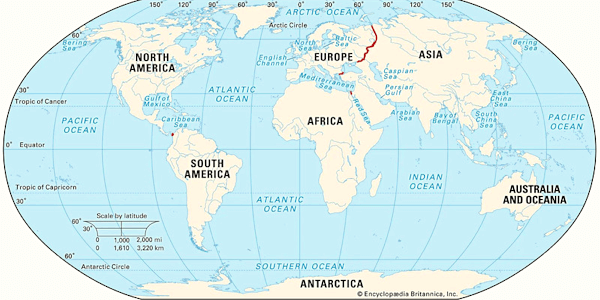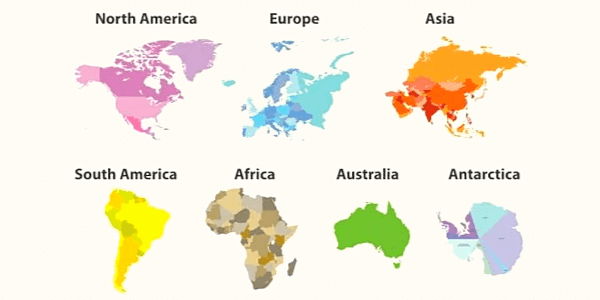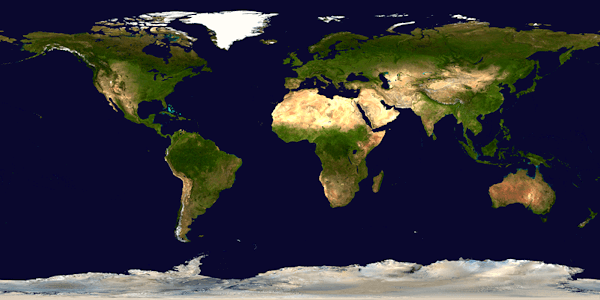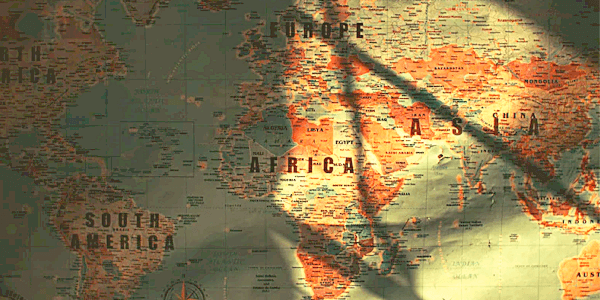The UPSC Prelims and Mains Exams require knowledge of geography. It is one of the most popular UPSC civil services test-optional subjects. We shall discuss the World Map Continent in this article. Continents are available on the world map, with a total of seven. Let’s look up the names of the 7 continents and other necessary details. This essay will assist you in learning the fundamental concepts of geography and the world. So Let’s begin!
Introduction: 7 Continents of the World
Landmasses and water bodies are the two primary types of landmasses on our planet. Oceans cover 71% of the Earth’s surface, while continents make up the remaining 29%. In this world, there are seven continents and five oceans. The landmasses, or continents, will be discussed in this article. Indeed, the world’s seven continents were combined into one massive landmass known as Pangaea billions of years ago. Plate tectonics, however, caused them to break apart and split eventually. According to a study, Europe and North America are still separating at a rate of 7 cm every year. Also, If North and South America are considered one continent, all of the world’s 7 continents begin and end with the same alphabet.
Asia, Europe, Africa, Australia, North America, South America, & Antarctica are the seven continents names that make up the world. So, let us take a look at each of these 7 continents listed on the world map. But, Before that, Click UPSC Study Materials to study more about other essential UPSC topics. For your UPSC preparation, we have covered a number of essential topics. So, remember to click on the provided link.

Asia
- Number of Countries: 48
- Population: 4,716,015,631
- Size: 44,579,000 sq. km
- Asia is the world’s largest continent in terms of both size & population among the 7 continents.
- Asia occupies one-third of the Earth’s surface and accounts for 30% of the global land area and 60% of the worldwide population.
- It is home to Russia, the world’s largest country, as well as China and India, the world’s two most populous countries.
- The continent is home to ten of the world’s tallest peaks. From orbit, the Great Wall of China is the only man-made structure visible.
- The top of Mount Everest, which is 29,028 feet 8,848 meters tall, is located in Asia.
- Reticulated pythons, tigers, pandas, yaks, and Indian rhinoceroses are some of the most common creatures found in Asia.
- Two enormous ancient civilizations arose in Asia: The Harappan and the Chinese civilizations.
- Hinduism, Islam, Buddhism, and Christianity all originated in Asia.
Africa
- Number of Countries: 54
- Population: 1,401,393,652
- Size: 30,221,532 sq km
- Africa is the second-largest continent in the world, after Asia.
- For thousands of years, the continent’s topography was uninhabitable and unknown, earning it the moniker “Dark Continent.”
- Africa is home to the world’s longest river, the Nile, and the world’s largest desert, the Sahara.
- Ethiopia, the world’s hottest country, is located in Africa.
- The Dark Continent is situated in the middle of the equator, receiving direct sunlight all year.
- Cheetah, African elephant, lion, zebra, Egyptian mongoose, giraffe, and addax are some of Africa’s most famous creatures.
- The Victoria Falls, Africa’s most fabulous waterfall, is located on the border between Zimbabwe and Zambia. Its height is 355 feet, and the span of the waterfall is about a mile.
- On the continent, more than half of the world’s French-speaking population resides.
- More than half of the world’s gold and 95% of the world’s diamonds come from Africa’s mineral-rich continent.
- The Dark Continent also provides 66% of the world’s chocolate.
Australia
- Number of Countries: 3
- Population: 26,058,980
- Size: 8,525,989 sq km
- Australia, the world’s smallest continent, is also regarded as an “island continent” since it is surrounded on all sides by water.
- Australia’s formal name is the Commonwealth of Australia.
- To distinguish it from the country of Australia, the continent of Australia is referred to as Sahul, Australinea, or Meganesia.
- Australia is a country that sits totally south of the equator and is typically referred to as “down under.” The name AustraAustralises from the Latin word “Australis,” which means “southern.”
Oceania
- To separate it from the Australian country, the name Oceania is also used to denote this region. On the other hand, Oceania is a continental group rather than a continent.
- Oceania is a phrase that refers to the Pacific Ocean’s smaller landmasses, principally Australia, New Zealand, and Papua New Guinea.
- Melanesia, Micronesia, and Polynesia are the three island regions (including the US state of Hawaii).
- Oceania is separated into three island groups: continental islands, high islands, and low islands, each made up of distinct elements.
- Also, Australia is one of the world’s 7 continents geologically. Therefore, The phrase is widely used in physical geography.
- Australia is made up of several islands, including Australia, New Guinea, Tasmania, Seram, and others.

Europe
- Number of Countries: 50
- Population: 748,494,989
- Size: 10,180,000 sq km
- Mt. Elbrus is the tallest peak on this continent.
- Some of Europe’s largest mountain ranges include the Balkans, Pyrenees, Apennines, Cantabrian, and Dinaric Alps.
- The Vatican City, the world’s tiniest country, is located in Europe.
- From all three sides, Europe is surrounded by water. The Arctic Ocean in the north, the Atlantic Ocean in the west, and the Mediterranean Sea in the south.
- The Caspian Sea & the Ural Mountains divide it from Asia.
- Europe is the world’s second-smallest continent, only behind Australia, with a land area of only 4,000,000 square miles.
- Because of the many lakes generated by melting ice sheets, Finland is known as the “Land of Lakes” in Europe.
- The Trans-Siberian Rail Route in Europe, which connects St Petersburg in the west to Vladivostok in the east, is the world’s longest rail route.
- Scandinavian countries include Norway, Sweden, Iceland, & Denmark.
- The Balkan states are comprised of Yugoslavia, Greece, Romania, and Albania.
- Iberia is made up of Spain and Portugal.
- Hedgehogs, roe deer, wild boards, blue tits, and European tree frogs are some of Europe’s most famous species.
- The continent’s principal food crops include maize, barley, rice, and oilseeds.
- The European Union produces three-quarters of the world’s potatoes.
- Europe’s longest river, the Volga, flows through Russia.
North America
- Number of Countries: 23
- Population: 373,163,025
- Size: 24,709,000 sq km
- North America is the only continent with all five time zones and every type of climate.
- North America is also known as the “New World” and was named after explorer Americo Vespucci.
- Also, it has the highest population density of the seven continents, at 22.9 people per square kilometer.
- Lake Superior, the world’s largest freshwater lake, is found on this continent.
- The Mississippi River (3778 km) is the world’s third-longest river.
- North America has the highest average per-person income among the continents.
- Also, Individual food intake is the highest on the continent.
- North America’s moose and elk are the continent’s first and second tallest animals.
- Brown bears, hummingbirds, bald eagles, brown bears, and bullfrogs are among the other important animals found in North America.
South America
- Number of Countries: 12
- Population: 437,486,561
- Size: 17,840,000 sq km
- It is the world’s fourth-largest continent by area and the fifth most populous out of 7 continents.
- It is made up of 12 countries and is largely located in the southern hemisphere, with a tiny section in the western hemisphere.
- The Amazon, the world’s largest river by volume and the second-longest (6440 km), is located in South America.
- The Angel Falls, the world’s highest waterfalls, are found on this continent.
- The green anaconda, the world’s largest and second-longest snake, is also found in South America.
- This continent is home to the world’s highest volcanoes, Mt. Cotopaxi and Mt. Chimborazo.
- Brazil is the world’s largest coffee producer and is located in South America.
- Also, Gold, silver, copper, iron ore, tin, and petroleum are the most important mineral resources of South America.
- Portuguese & Spanish are the most widely spoken languages on this continent.
- The Andes are the world’s second-highest mountain range, after the Himalayas.
- The llama, anaconda, piranha, jaguar, vicua, and tapir are just a few of the fascinating and unusual animals found in South America.
Antarctica
- Number of Countries: 0
- Population: The population of Antarctica is primarily made up of scientists working on research projects. Therefore, The number of residents varies from roughly 1,100 during the severe Antarctic winter to around 4,400 during the calmer summer months of October to February, with an additional 1,000 employees stationed nearby.
- Size: 14,000,000 sq km
- Antarctica is the world’s fifth-largest continent. It is the only continent that is totally uninhabited.
- It is the world’s driest and coldest continent.
- Three oceans surround it: the Indian Ocean, the Pacific Ocean, and the Atlantic Ocean.
- Antarctica experiences half a year of daylight and half a year of darkness. Also, the summer months of December to February have 24 hours of daylight, while the winter months of late March to late September are completely dark.
- The interior of the Frozen Continent is roughly -35 degrees Celsius. Also, the beaches are around 2 degrees Celsius. In the winter, the temperature in the interior is -70 degrees Celsius, while the coastlines are 2 degrees Celsius.
- In 1960, Ramcharan Jee became the first Indian to reach Antarctica.
- Also, Belgica Antarctica, a 1.3 cm long insect, is the largest terrestrial animal in Antarctica.
- The research bases, where experts from various countries come to do their work, are the only permanent settlements in Antarctica.
- Therefore, Antarctica is home to penguins, with Adelie penguins being the most prevalent.

Conclusion– 7 Continents
As a result, we’ve covered the seven (7) continents’ names and information about them in this article. We studied the names of the world’s 7 continents, where they are located, how many countries are on each continent, and so on. Continents are visible on the world map, and there are seven of them. Also, Here’s a link to the UPSC’s official webpage. Exam details and updated notices are available at the above Link for aspirants.

FAQ– 7 Continents
Africa, Antarctica, Asia, Australia (Oceania), Europe, South America, and North America are the name of seven (7) continents visible on the world map.
The equator is an invisible line that splits the planet into two equal halves, the northern and southern. therefore, It travels through 13 countries, three continents, & 3 bodies of water. Thus, South America, Africa, and Asia make up the three continents. The Atlantic Ocean, Pacific Ocean, and the Indian Ocean are the three aquatic regions through which the equator travels. Ecuador, Colombia, Brazil, Gabon, Congo, Democratic Republic of Congo, Sao Tome and Principe, Somalia, Maldives, Uganda, Kenya, Indonesia, and Kiribati are among the thirteen nations through which the equator travels.
Asia is the world’s largest continent.
Editor’s Note | 7 Continents
In conclusion, The 7 continents are the subject of this essay. We learned about the continents, the world’s 7 continents, their names, map, and other related information. You can also discover additional articles and important information on our website. Thus, These notes, we believe, will be beneficial to you. Finally, Best wishes!







